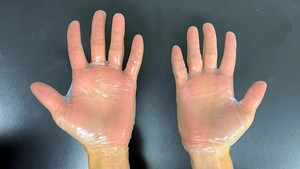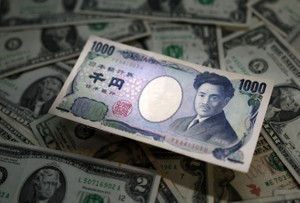By KOICHI AMANO/ Staff Writer
December 9, 2023 at 07:00 JST
ISAHAYA, Nagasaki Prefecture--On a recent day, the completion ceremony of an artwork commissioned by a Buddhist priest was held at the long-established Tenyuji temple in the Nishi-Kojimachi district here.
Featured in the work is an unusual image added to the iconic Madonna and Child painting.
In it, the mother of Jesus is portrayed as the Kannon bodhisattva, a Buddhist deity.
Tetsujo Suda, chief monk of Tenyuji, conceived of the artwork featuring not only his own faith but also Christianity.
Suda's aim is shedding a ray of light on the tragic history of Buddhism in Nagasaki Prefecture. Building a bridge between the two religions is also an objective.
“Not only confrontation between religions, but also conflicts and discrimination among different groups of people are contributing to a plethora of tragedies the world over,” Suda said. “My hope is our modest endeavor to value universality will help realize peace.”
RELIGIOUS PERSECUTION A DARK CHAPTER
Local spots linked to those who practiced Christianity in secrecy due to the violent crackdown on Christians in the Edo Period (1603-1867) have been inscribed on the UNESCO World Cultural Heritage list. A constant stream of people visit those destinations.
In the meantime, warlords believing in Christianity during the Sengoku (Warring States) period (1467-1568) persecuted Buddhists in their domains. The plight of Buddhism is not as well known.
Explaining why he commissioned the work themed on Mary and Jesus despite his adherence to Buddhism, Suda, 56, said he wanted many people to remember a dark chapter in regional history.
The project was inspired by the conversations he had with officials from Nagasaki Prefecture and Isahaya city in their visits to Tenyuji where they come for cultural studies and other purposes.
Areas around Tenyuji, which served as a warlord’s family temple, were home to many Christian lords’ domains. A spate of temples were destroyed amid the spread of Christianity.
The officials from the prefecture and the city called Tenyuji “precious in its proximity because few Buddhism-related cultural properties remain in existence on the grounds of the domains of Christian warlords.”
Michitaka Kanda, 43, a pastor and researcher at Chinzei Gakuin University, who studies the oppression of Buddhism during the Sengoku Period, said a signboard recounts the story.
Standing in what is now known as Omura city and ruled by the Omura clan who belonged to the Christian faith, it reads a “fleeing temple head was killed and buried at the time of the Christians’ assault on temples and shrines.”
Kanda learned through a closer look into the violence that the mentor of the slaughtered temple chief spent the rest of his life at a humble hut a short distance away to protect the principal image of the temple.
This tragedy may remind people of the way the persecuted Christians sustained their conviction in hiding.
According to Kanda’s research, only a limited number of records on the Buddhism side refer to the suffering inflicted on its followers, so their plight can typically only be inferred from folk stories.
A host of reports by Christian missionaries, by contrast, show vividly what they did for Buddhists to embrace the foreign doctrine.
Noticing this disparity, Suda wondered if the persecution victims renounced their faith immediately in regions managed by Christian lords. However, he thought that they must have adhered to their beliefs like their Christian counterparts.
This notion got Suda to hit upon the possibility of the oppressed Buddhists praying to their own symbols of worship disguised as Christian icons in a quest to preserve their faith.
Suda decided to create a Madonna and Child painting but portray the mother of Jesus as the Kannon bodhisattva.
ARTIST GIVES SHAPE TO VISION
Suda asked Rina Matsudaira, 33, a painter from Kyoto Prefecture, to work on the creation.

Matsudaira is famed for her representational pieces depicting people and other motifs in the traditional Japanese painting style. She has been a Christian churchgoer since childhood.
For that reason, Suda found Matsudaira the best artist to give shape to his concept.
Matsudaira toured the Goto island chain of Nagasaki Prefecture to examine Christianity-relevant locations there. She learned Buddhist teachings from Suda in formulating the picture’s design.
Perfecting the work that resembles a Catholic altarpiece took six months. The grand painting is 130 centimeters long and 160 cm wide.
Mary and Jesus are illustrated on it. But the sacred mother looks as if she is Kannon at the same time. Kannon typically has a lotus flower but a rose is held in the bodhisattva’s hand instead as part of Matsudaira’s unique twist.
Depending on which followers to save, Kannon is believed to change form.
“From a Buddhist perspective, Kannon can be interpreted as making an appearance as the Virgin Mary in front of Christians,” Suda said.
The unorthodox piece of art represents Suda’s hope.
“Seeking what different religions have in common seems more important than stressing their differences to fuel confrontation,” he said.
After finishing the painting, Matsudaira agreed.
“I am a Christian but gave thought to philosophies in Buddhism in my process of mastering Japanese-style painting,” she said. “I feel the religions may share some concepts.”
The completed artwork went on display at the Catholic Tamatsukuri Church in Osaka's Chuo Ward through the mediation of Matsudaira, who is a church member.
The major church sits in the site marked by a stone statue of the renowned Japanese Christian Hosokawa Gracia (1563-1600), who is said to have died nearby.
Toshihiro Sakai, auxiliary bishop of the Archdiocese of Osaka-Takamatsu, praised Suda for the project.
“The painting is easy to accept as it displays a soft touch typical of Japanese drawings while maintaining a divine ambience,” said Sakai. “The idea of transcending religious frameworks sounds very nice to me. Dialogue between religions is an important theme for Catholicism, too.”
The Madonna and Child artwork is expected to be exhibited at “higan” services and other Buddhism events.
Suda believes offering prayers will contribute to crossing religious boundaries.




















Stories about memories of cherry blossoms solicited from readers
Cooking experts, chefs and others involved in the field of food introduce their special recipes intertwined with their paths in life.
A series based on diplomatic documents declassified by Japan’s Foreign Ministry
A series on the death of a Japanese woman that sparked a debate about criminal justice policy in the United States
A series about Japanese-Americans and their memories of World War II
Here is a collection of first-hand accounts by “hibakusha” atomic bomb survivors.